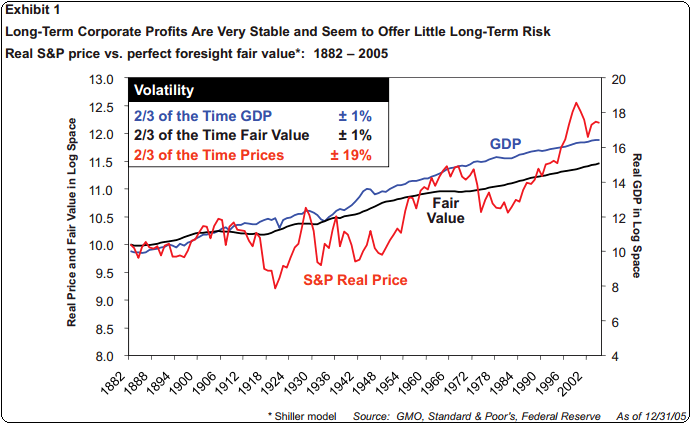As always Jeremy Grantham’s quarterly letter is a must read. The most interesting part to me is the initial bit on herding:
“The central truth of the investment business is that investment behavior is driven by career risk. In the professional investment business we are all agents, managing other peoples’ money. The prime directive, as Keynes knew so well, is first and last to keep your job. To do this, he explained that you must never, ever be wrong on your own. To prevent this calamity, professional investors pay ruthless attention to what other investors in general are doing. The great majority “go with the flow,” either completely or partially. This creates herding, or momentum, which drives prices far above or far below fair price. There are many other inefficiencies in market pricing, but this is by far the largest. It explains the discrepancy between a remarkably volatile stock market and a remarkably stable GDP growth, together with an equally stable growth in “fair value” for the stock market. This difference is massive – two-thirds of the time annual GDP growth and annual change in the fair value of the market is within plus or minus a tiny 1% of its long-term trend as shown in Exhibit 1. The market’s actual price – brought to us by the workings of wild and wooly individuals – is within plus or minus 19% two-thirds of the time. Thus, the market moves 19 times more than is justifi ed by the underlying engines! This incredible demonstration of the behavioral dominating the rational and the “efficient” was first noticed by Robert Shiller over 20 years ago and was countered by some of the most tortured logic that the rational expectations crowd could offer, which is a very high hurdle indeed. Shiller’s “fair value” for this purpose used clairvoyance. He “knew” the future flight path of all future dividends, from each starting position of 1917, 1961, and all the way forward. The resulting theoretical value was always stable (it barely twitched even in the Great Depression), but this data was widely ignored as irrelevant. And ignoring it may be the correct response on the part of most market players, for ignoring the volatile up-and-down market moves and attempting to focus on the slower burning long-term reality is simply too dangerous in career terms. Missing a big move, however unjustifi ed it may be by fundamentals, is to take a very high risk of being fired. Career risk and the resulting herding it creates are likely to always dominate investing. The short term will always be exaggerated, and the fact that a corporation’s future value stretches far into the future will be ignored. As GMO’s Ben Inker has written, two-thirds of all corporate value lies out beyond 20 years. Yet the market often trades as if all value lies within the next 5 years, and sometimes 5 months.”

These are sharp comments. It can be comforting to run with the crowd. But you also don’t know when the crowd is running towards a cliff. So there’s a certain safety in the crowd, but also an elevated and unknown risk. Sometimes it’s best to run by yourself. This is why I prefer a multi-strategy approach. You’re not running with crowds. You’re running along side them at times, but mostly just watching the crowd from the distance. And more importantly, if you run off the cliff you have no one to blame but your own stupidity for not being more cautious in the direction and speed with which you were running….
Mr. Roche is the Founder and Chief Investment Officer of Discipline Funds.Discipline Funds is a low fee financial advisory firm with a focus on helping people be more disciplined with their finances.
He is also the author of Pragmatic Capitalism: What Every Investor Needs to Understand About Money and Finance, Understanding the Modern Monetary System and Understanding Modern Portfolio Construction.

Comments are closed.